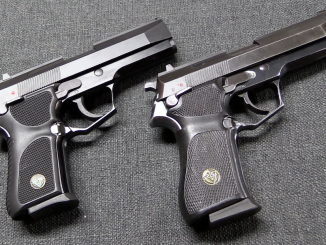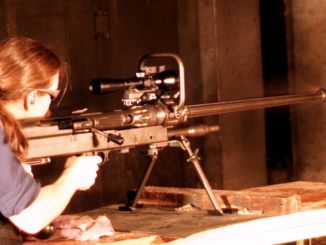The Pretoria Arms Factory was founded in 1954 by Piet Nagel and Jan Willem Dekker. both Dutch immigrants to South Africa after WW2. They began manufacturing a simplified copy of the Baby Browning pocket pistol, chambered for the .25 ACP (6.35mm Browning) cartridge. This appears to be the first domestic South African commercial firearms production, which gives the gun more historical significance than its design and production would otherwise justify. The initial 500 or so guns had a flaw in the frame design which led to the front of the barrel retaining lug breaking off when the slide went into battery, sending the barrel and frame flying off the front of the gun. The problem was fixed relatively quickly, but not quickly enough to save the reputation of the company.
After the bankruptcy of the P.A.F. company, its assets were purchased by one Bertram Rudolph Freiling, and he attempted to restart production under the brand name BRF. This was unsuccessful, with only a few hundred BRF pistols made. Today, the PAF guns are relatively accessible in South Africa, and can also be found in the United States and Europe. The white plastic grips are virtually all shrunken and cracked, however.




“P.A.F. Junior”
According to unblinking eye: https://unblinkingeye.com/Guns/PAF/paf.html
These guns are often difficult to disassemble and even more difficult to reassemble. The slide lock pin (mentioned in the second paragraph) should be pressed down by the slide when you push it forward, but it sometimes gets stuck and may need to be lubricated.
It also report grips to be not durable and also mention existence of .32 version prototype.
If anyone is aware of existence of particular PAF Junior, then might deliver that information (serial number) to unblinking eye.
“first domestic South African commercial firearms production”
Can somebody sum South African 1950s legal aspect of fire-arms possessions? If it allowed easier obtaining for .25 Auto than say .32 Auto or .380 Auto-chambered automatic pistols, this might explains why it is relatively big for its caliber. Dimension-wise it seems to be roughly equal to Mauser Model 1910.
A.B.Zhuk report existence of two variants differing in sights (early “protruding” and late “non-protruding”), gives overall length as 111 mm and capacity as 7.
By the way: is it known, why there are more vest pocket pistol construction with recoil spring below the barrel, than construction with recoil spring around the barrel? I think the latter one is simpler and more compact solution.
If I am not mistaken spring below (or above) allows to create slimmer automatic pistol.
“If I am not mistaken spring below (or above) allows to create slimmer automatic pistol.”
Yes, I think so. But I also think, a few millimeter wider pistol is not so important (even in the vest pocket pistol category), than the simplicity (fewer part and lower manufacturing cost).
Probably the answer is in connection with the properties of coil springs. A coil spring with smaller diameter is stiffer, than a coil spring with larger diameter (if the other properties are identical). In a vest pocket pistol there is no room for longer coil springs. But this is only my idea and theory.
By the way, I should compare the dimensions of a few vest pocket pistols with recoil spring below the barrel and around the barrel.
In case of early 20th century design it might be caused by what springs were already in production, as around barrel means you need spring of given length, given inner diameter and given outer diameter, while in other case there is no issue of inner diameter and length is not depending on barrel length.
“few millimeter wider pistol is not so important (even in the vest pocket pistol category)”
I think users from early 20th century might have different opinion, as these automatic pistol were carried literally in vest pocket.
Most of spring around the barrel models are in blowback operation using fixed, unremovable barrels using the same as the frontal guide for slide reciprocal movement and if the gun being of striker fired, the striker tunnel at back can also usable as slide recprocal movement at the rear by the aid of movable striker rear plug. This combination eliminates the necessity of slide guide rails and preferred by the manufacturers to lower the cost. Some of old vest pocket pistols use
the same feature with the recoil spring under the fixed, open top barrel with thin slide side walls for the sake of being in lesser weight. Menz Llliput and Walther Model9 of 1920’s are the forerunners of this concept.
I am confused about one thing. Does this look more like a FN 1906/Colt 1908 which was discontinued in 1959 less like the “Baby Browning” introduced in 1931?
As far as I know, Browning’s FN Model 1906/Colt 1908 Vest Pocket and Dieudonné Saive’s FN Baby Browning are one of the most copied pistols, and they inspired many designs.
This gun resemles FN1906 outwardly, but seeming to follow Baby Browning inwardly especially at trigger mechanism.
Wow was doing some research on this littl piece because my step dad gave it to me to mess around with, and low and behold an article 2 days old about it. Thanks for the information. Pretty excited to fire it. Might just take it off his hands for him =)
I own a PAF junior serial number is A4862 . unsure of the caliber. on the barrel it says 35mm but that might be something else
Apparently there was another South African knockoff of the 6.35mm Baby Browning in stainless steel marked “FINAT” on the handle. The only noticeable difference being the barrel rotates clockwise and not counter-clockwise (like with the Browning) for stripping. Despite all my efforts, I have yet do uncover more written info on these rarities.